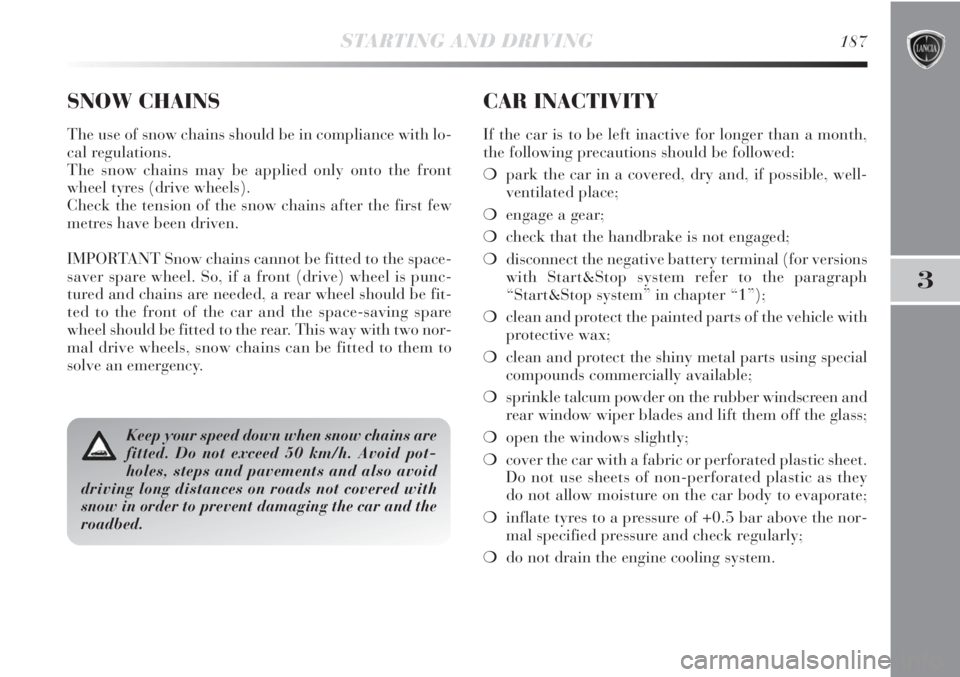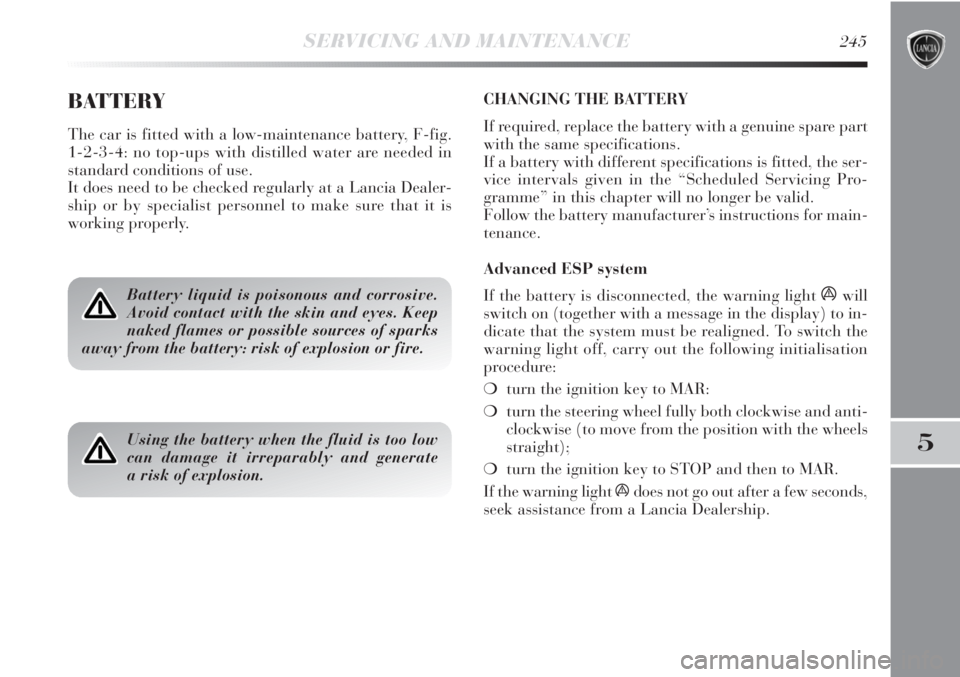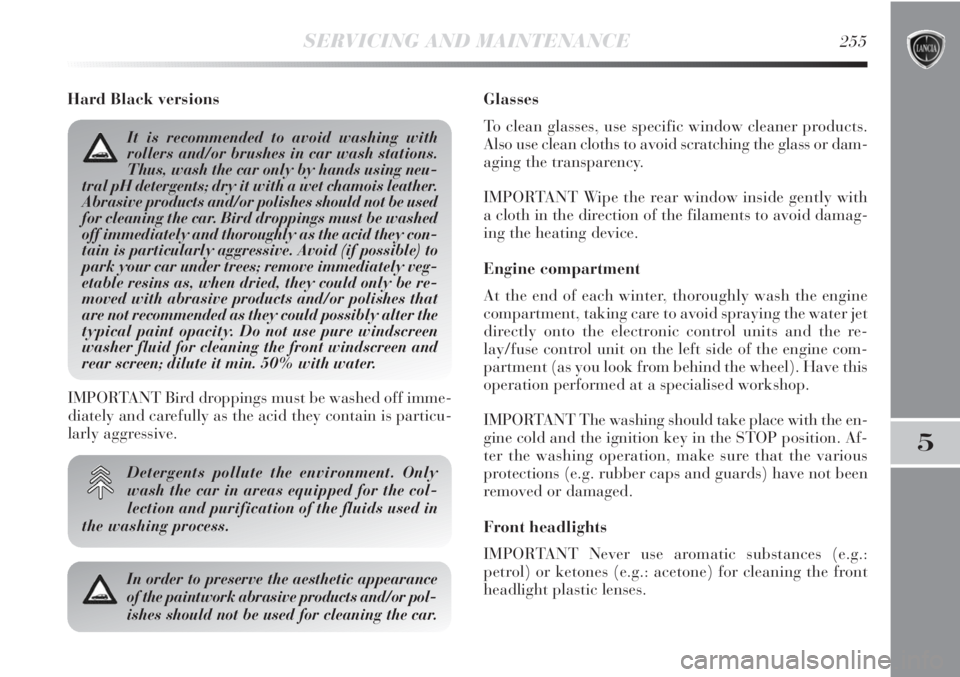spare wheel Lancia Delta 2012 Owner handbook (in English)
[x] Cancel search | Manufacturer: LANCIA, Model Year: 2012, Model line: Delta, Model: Lancia Delta 2012Pages: 295, PDF Size: 8.29 MB
Page 134 of 295

132KNOWING YOUR CAR
Contact
a Lancia Dealership
Repair the damaged
wheel
Contact
a Lancia Dealership
–
Contact
a Lancia Dealership
––
NO
NO
YES
YES
YESYES
YES
YES
NO
NO
NO
(*) Given as an alternative in the Owner Handbook and available at Lineaccessori Lancia.
(**) Not cross-swapped (tyres must stay on the same side).
In order to use the system properly, refer to the following table when you have to change wheels/tyres:
Operation Sensor Fault indication Lancia Authorized
Services intervention
–
Replacing a wheel
with the spare wheel
Replacing the wheels
with winter tyres
Replacing the wheels
with winter tyres
Replacing wheels
with others of a different size (*)
Switching wheels
(front/rear) (**)
Page 189 of 295

3
STARTING AND DRIVING187
Keep your speed down when snow chains are
fitted. Do not exceed 50 km/h. Avoid pot-
holes, steps and pavements and also avoid
driving long distances on roads not covered with
snow in order to prevent damaging the car and the
roadbed.
SNOW CHAINS
The use of snow chains should be in compliance with lo-
cal regulations.
The snow chains may be applied only onto the front
wheel tyres (drive wheels).
Check the tension of the snow chains after the first few
metres have been driven.
IMPORTANT Snow chains cannot be fitted to the space-
saver spare wheel. So, if a front (drive) wheel is punc-
tured and chains are needed, a rear wheel should be fit-
ted to the front of the car and the space-saving spare
wheel should be fitted to the rear. This way with two nor-
mal drive wheels, snow chains can be fitted to them to
solve an emergency.
CAR INACTIVITY
If the car is to be left inactive for longer than a month,
the following precautions should be followed:
❍park the car in a covered, dry and, if possible, well-
ventilated place;
❍engage a gear;
❍check that the handbrake is not engaged;
❍disconnect the negative battery terminal (for versions
with Start&Stop system refer to the paragraph
“Start&Stop system” in chapter “1”);
❍clean and protect the painted parts of the vehicle with
protective wax;
❍clean and protect the shiny metal parts using special
compounds commercially available;
❍sprinkle talcum powder on the rubber windscreen and
rear window wiper blades and lift them off the glass;
❍open the windows slightly;
❍cover the car with a fabric or perforated plastic sheet.
Do not use sheets of non-perforated plastic as they
do not allow moisture on the car body to evaporate;
❍inflate tyres to a pressure of +0.5 bar above the nor-
mal specified pressure and check regularly;
❍do not drain the engine cooling system.
Page 201 of 295

IN AN EMERGENCY199
4
REPLACING A WHEEL
GENERAL INSTRUCTIONS
The car may be originally fitted with a space-saver wheel
(for versions/markets, where provided).
Wheel changing and correct use of the jack and spare
wheel call for some precautions as listed below.
The space-saver wheel (for versions/mar kets
where provided) is specific to your car, do not
use it on other models, or use the spare wheel
of other models on your car. The space-saver wheel
must only be used in case of emergency. Never use
it for more than strictly necessary and never exceed
80 km/h. On the space-saver wheel there is an or-
ange label, summarising the main warnings re-
garding space-saver wheel usage restrictions.
Never remove or cover the label. Never ap-
ply a hub cup on a space-saver wheel. The
following information is provided in four
languages on the label: IMPORTANT! FOR TEM-
PORARY USE ONLY! 80 KM/H MAX.! REPLACE
WITH STANDARD WHEEL AS SOON AS POS-
SIBLE. DO NOT COVER THIS LABEL.
If you change the type of wheel (alloy rims instead
of steel rims) you will have to change the entire set
of fastening bolts with another set of suitably sized
bolts.
Alert other drivers that the car is stationary
in compliance with local regulations: haz-
ard warning lights, warning triangle, etc.
Any passengers on board should leave the car, es-
pecially if it is heavily laden. Passengers should
stay away from on-coming traffic while the wheel
is being changed. If parked on a slope or rough sur-
face, chock the wheels with wedges or other suit-
able devices.
Page 207 of 295

IN AN EMERGENCY205
4
REFITTING THE STANDARD WHEEL
Following the procedure described previously, raise the
car and remove the space saver spare wheel.
Versions with steel rims
Proceed as follows:
❍make sure the contact surfaces between standard
wheel and hub are clean so that the fastening bolts
will not come loose;
❍fit the standard wheel inserting the 4 bolts into the
holes;
❍using the wrench provided, tighten the fastening bolts;
❍press-fit the hub cap, aligning the special splining (on
the cap) with the inflation valve;
❍lower the car and remove the jack;
❍using the wrench provided, fully tighten the bolts in
the sequence shown previously.Versions with alloy wheels
❍Place the wheel onto the hub and tighten the bolts us-
ing the wrench provided;
❍lower the car and remove the jack;
❍using the spanner provided, fully tighten the bolts in
the sequence shown in fig. 8;
❍refit the press-fitted hub cap, making sure that the
reference hole on the wheel is aligned with the refer-
ence pin on the cap.
IMPORTANT If it is not fitted properly, the hub cap may
detach when the vehicle is running.
Page 208 of 295

206IN AN EMERGENCY
After tyre replacement
❍Stow the space saver wheel D-fig. 10 in the space pro-
vided in the luggage compartment;
❍fit the partially open jack in its box forcing it lightly
to prevent it from vibrating when travelling;
❍put the tools back into place in the container;
❍stow the container, complete with tools, in the spare
wheel and tighten the locking device B-fig. 10;
❍reposition the boot mat correctly.
IMPORTANT Do not use inner tubes with tubeless tyres.
Check the inflation pressure of the tyres and the space-
saving wheel periodically.CHANGING A BULB
GENERAL INSTRUCTIONS
❍Before changing a bulb, check the contacts for rust-
ing;
❍burnt-out bulbs must be replaced by others of the
same type and wattage;
❍always check the alignment of the beam after chang-
ing a headlight bulb;
❍when a light is not working, check that the corre-
sponding fuse is intact before changing a bulb. For the
location of fuses, refer to the paragraph “Replacing
fuses” in this chapter.
Modifications or repairs to the electric sys-
tem that are not carried out properly or do
not take the system technical specifications
into account can cause malfunctions leading to the
risk of fire.
Various fastening bolts and space-saver
wheels, specific and differing in structural
characteristics, are used depending on the
wheel rim type (alloy or steel). Fastening bolts for
alloy rims can be identified by the presence of a per-
manent washer and a hollow side on the bolt head.
Therefore, you will need to go to a Lancia Dealer-
ship to get the correct type of fastening bolts and
space saver wheel if you change the type of wheels
fitted (alloy rims instead of steel rims, or vice
versa). Keep the bolts fitted as standard in case of
re-use of the wheels originally mounted on the car.
Page 247 of 295

SERVICING AND MAINTENANCE245
5
BATTERY
The car is fitted with a low-maintenance battery, F-fig.
1-2-3-4: no top-ups with distilled water are needed in
standard conditions of use.
It does need to be checked regularly at a Lancia Dealer-
ship or by specialist personnel to make sure that it is
working properly.
Battery liquid is poisonous and corrosive.
Avoid contact with the skin and eyes. Keep
naked flames or possible sources of sparks
away from the battery: risk of explosion or fire.
Using the battery when the fluid is too low
can damage it irreparably and generate
a risk of explosion.
CHANGING THE BATTERY
If required, replace the battery with a genuine spare part
with the same specifications.
If a battery with different specifications is fitted, the ser-
vice intervals given in the “Scheduled Servicing Pro-
gramme” in this chapter will no longer be valid.
Follow the battery manufacturer’s instructions for main-
tenance.
Advanced ESP system
If the battery is disconnected, the warning light
áwill
switch on (together with a message in the display) to in-
dicate that the system must be realigned. To switch the
warning light off, carry out the following initialisation
procedure:
❍turn the ignition key to MAR:
❍turn the steering wheel fully both clockwise and anti-
clockwise (to move from the position with the wheels
straight);
❍turn the ignition key to STOP and then to MAR.
If the warning light ádoes not go out after a few seconds,
seek assistance from a Lancia Dealership.
Page 257 of 295

SERVICING AND MAINTENANCE255
5
Hard Black versions
Detergents pollute the environment. Only
wash the car in areas equipped for the col-
lection and purification of the fluids used in
the washing process.
Glasses
To clean glasses, use specific window cleaner products.
Also use clean cloths to avoid scratching the glass or dam-
aging the transparency.
IMPORTANT Wipe the rear window inside gently with
a cloth in the direction of the filaments to avoid damag-
ing the heating device.
Engine compartment
At the end of each winter, thoroughly wash the engine
compartment, taking care to avoid spraying the water jet
directly onto the electronic control units and the re-
lay/fuse control unit on the left side of the engine com-
partment (as you look from behind the wheel). Have this
operation performed at a specialised workshop.
IMPORTANT The washing should take place with the en-
gine cold and the ignition key in the STOP position. Af-
ter the washing operation, make sure that the various
protections (e.g. rubber caps and guards) have not been
removed or damaged.
Front headlights
IMPORTANT Never use aromatic substances (e.g.:
petrol) or ketones (e.g.: acetone) for cleaning the front
headlight plastic lenses.
In order to preserve the aesthetic appearance
of the paintwork abrasive products and/or pol-
ishes should not be used for cleaning the car.
IMPORTANT Bird droppings must be washed off imme-
diately and carefully as the acid they contain is particu-
larly aggressive.
It is recommended to avoid washing with
rollers and/or brushes in car wash stations.
Thus, wash the car only by hands using neu-
tral pH detergents; dry it with a wet chamois leather.
Abrasive products and/or polishes should not be used
for cleaning the car. Bird droppings must be washed
off immediately and thoroughly as the acid they con-
tain is particularly aggressive. Avoid (if possible) to
park your car under trees; remove immediately veg-
etable resins as, when dried, they could only be re-
moved with abrasive products and/or polishes that
are not recommended as they could possibly alter the
typical paint opacity. Do not use pure windscreen
washer fluid for cleaning the front windscreen and
rear screen; dilute it min. 50% with water.
Page 272 of 295

205/55 R16-91V
125/90 R15-96
195/55 R16-91VXL
205/55 R16-91V
225/45 R17-91W
225/40 R18-92W2.7 2.5
2.7 2.5
2.7/2.8 (*) 2.5
2.9/3.1 (*) 2.7
270TECHNICAL SPECIFICATIONS
2.4 2.2
2.4 2.2
2.4 2.2
2.6 2.4
Add +0.3 bar to the prescribed pressure when the tyres are warm. Check correct pressure on a cold tyre.
With snow tyres, add +0.2 bar to the inflation pressure value prescribed for standard tyres.
When travelling at speeds over 160 km/h, inflate the tyres to the values specified for fully laden conditions.
The TPMS is not fitted with 195/55 R16 91V tyres.
COLD TYRE PRESSURES (bar)
2.2
4.2
SPACE-SAVER/SPARE WHEEL
Size Inflation pressure
Size STANDARD TYRES
Medium load Full load
Front Rear Front Rear
(*) 1.9 Twin Turbo Multijet and 2.0 Multijet versions